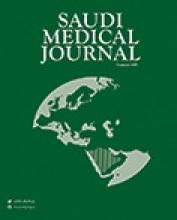Abstract
OBJECTIVE: To review the results of blood culture in febrile children seen in the pediatric emergency department over a 3 year period.
METHODS: A retrospective cohort study was conducted in the Pediatric Emergency Department, King Abdul-Aziz University Hospital between January 2001 and December 2003 on 2929 highly febrile children (temperature >/=39.50C), aged 2-36 months whose blood culture results were evaluated. Prevalence of bacteremia, positive blood culture, and distribution of pathogenic organisms were determined. All patients growing known pathogenic bacteria were reevaluated, and serious outcome was assessed.
RESULTS: Two thousand nine hundred and twenty nine children met the inclusion criteria. The mean age of patients was 10.75 months, 52% of them were boys, and 48% were girls. The prevalence of bacteremia was 1.6%. Streptococcus pneumoniae was the causative agent in 37% of patients. The contamination rate was 2.2%. The mean time to positive culture was significantly shorter for pathogenic organisms (18±1.5 hours) than the non-pathogenic organism (24±4 hours).
CONCLUSION: The risk factors in highly febrile children included younger age group below 24 months of age, and increase in white blood cells of more than 15,000 cell/mm3. The study also indicates that there is an increase in prevalence of Streptococcus pneumoniae resistance to ampicillin and penicillin, which necessitates the need for a polyvalent pneumococcal conjugate vaccine to be added to the routine immunization program in the Kingdom.
- Copyright: © Saudi Medical Journal
This is an open-access article distributed under the terms of the Creative Commons Attribution-Noncommercial-Share Alike 3.0 Unported, which permits unrestricted use, distribution, and reproduction in any medium, provided the original work is properly cited.






